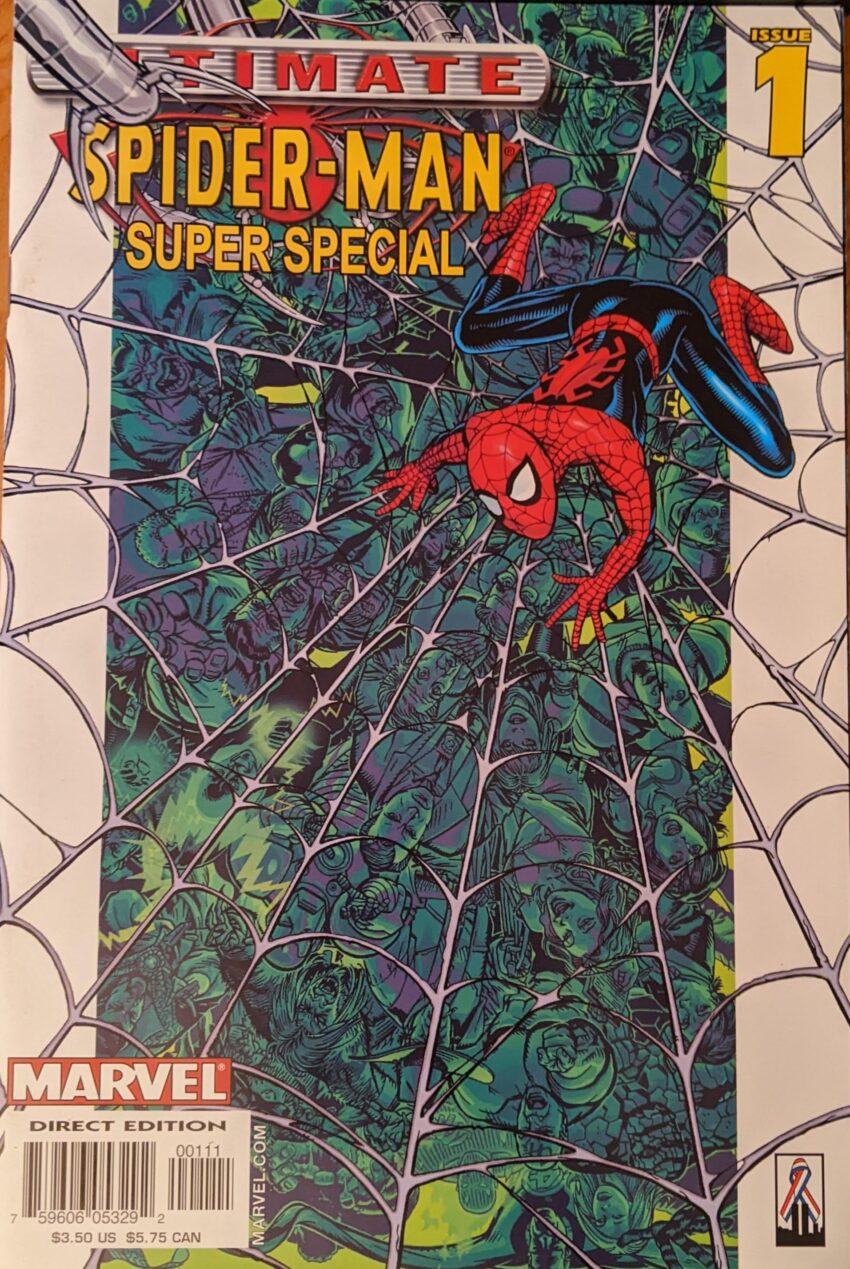Behold it. Published the same month as UMTU 16, the real grand finale of the series arrives in an oversized “jam book.” I think this is the first place he does it, but Bendis will come to love this format, getting a ton of artists to draw a single issue. And, I mean, showing off a bunch of different artists is cool, but the thing is, these things are rarely satisfying reads. They have to be kind of high level stories to manage so many peoples’ schedules. They’re not the best, and B loves them. At any rate, this book brings in a ton of artists, some who worked on UMTU, some new ones, to close out the title in a comic that doesn’t even share its name. Very weird! The cover is by Michael Golden, who we’ve seen ‘round the blog a few times. You can see why he colored it this way (And I feel pretty confident he colored it), but all the characters who aren’t Spider-Man just vanish into the green muck. He went to the trouble of drawing basically everyone who’d ever appeared in USM or UMTU to this point and then made it hard to see any of them. A recap page illustrated by Alex Maleev kicks it off. If memory serves, Alex had already drawn this Spider-Man, and it was just repurposed in this book:
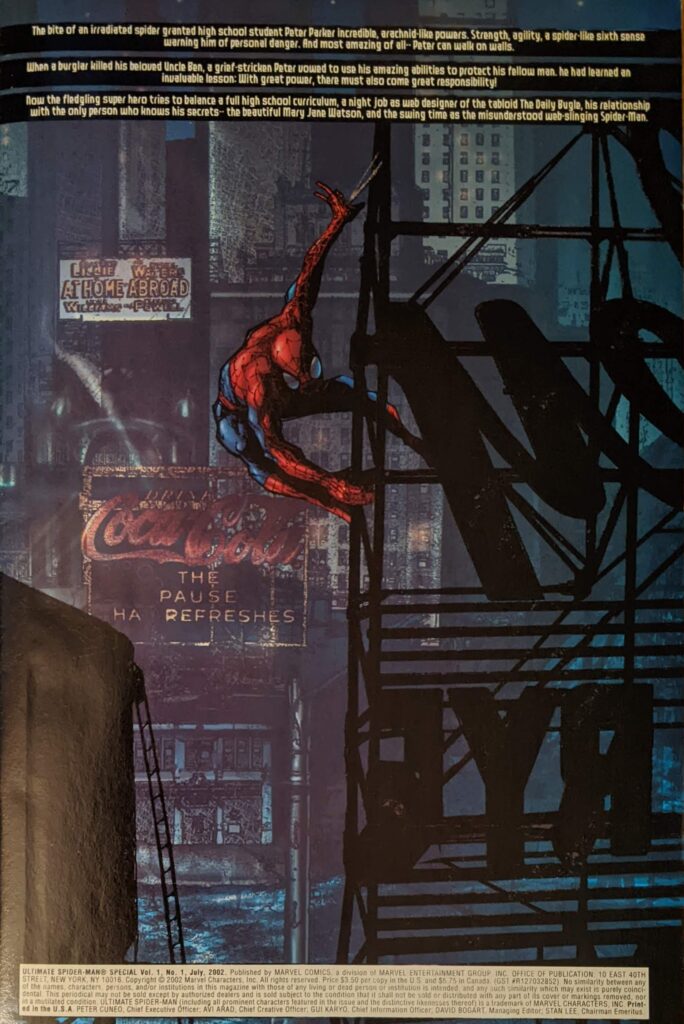
That’s not even technically the right Spider-Man, not that you could tell. Alex Maleev is a major figure in my own evolution as an artist, but since he’ll be appearing for more than one page in an upcoming post, I’ll talk about that later. Next up, Dan Brerton, known for spooky stuff, gets an unusual-in-this-comic-and-this-format 6 pages as Spider-Man encounters Ultimate Blade.
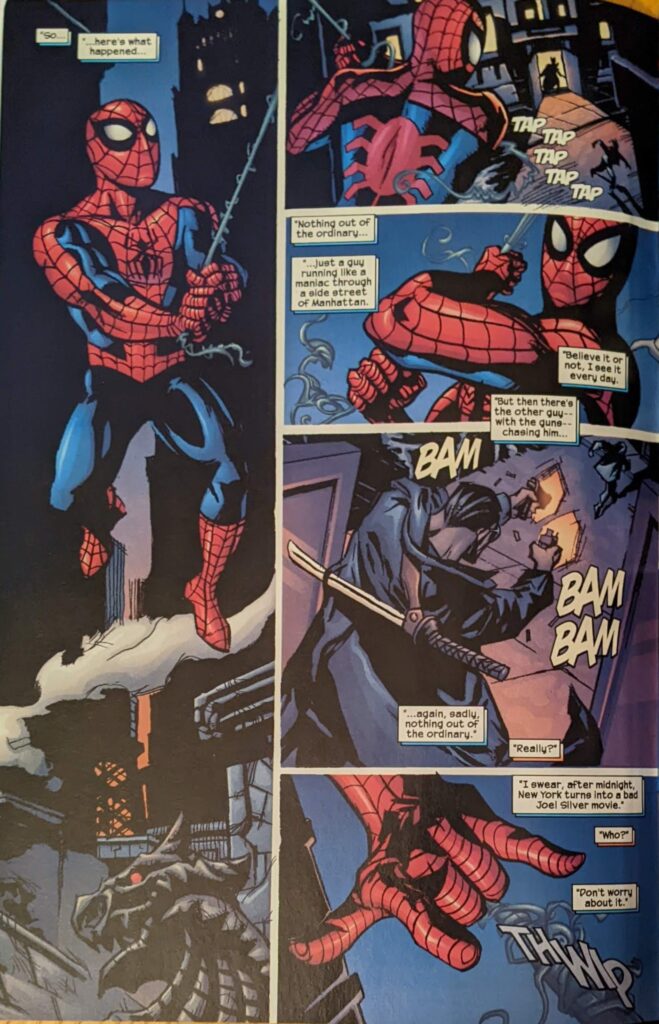
Spidey webbed up the guy who looked like the threat, as he tends to do, then went to help the victim, and, well…
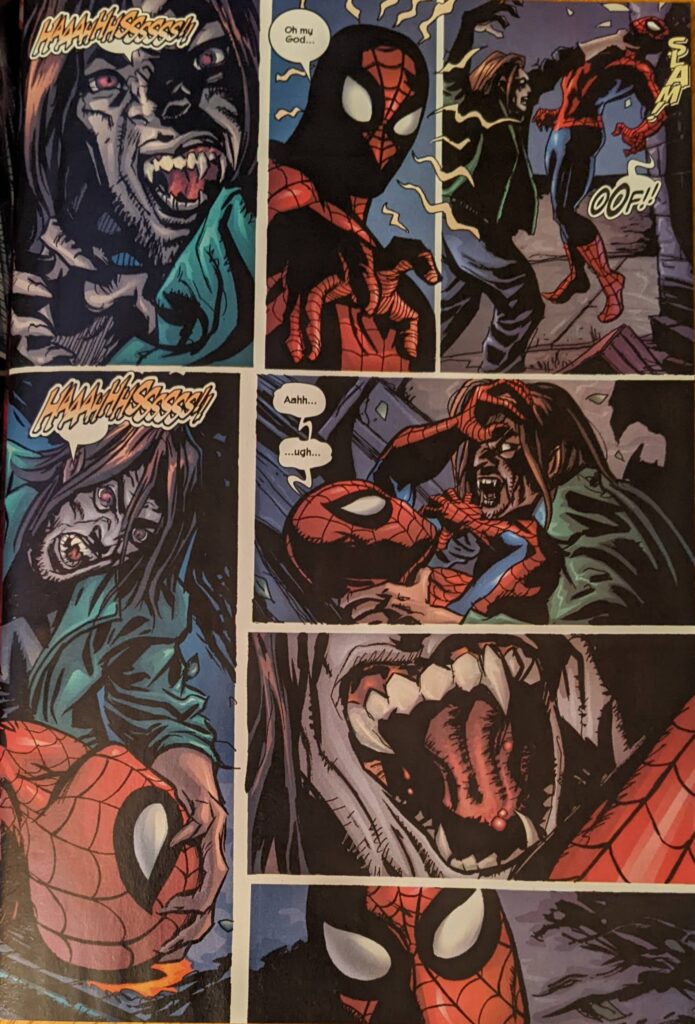
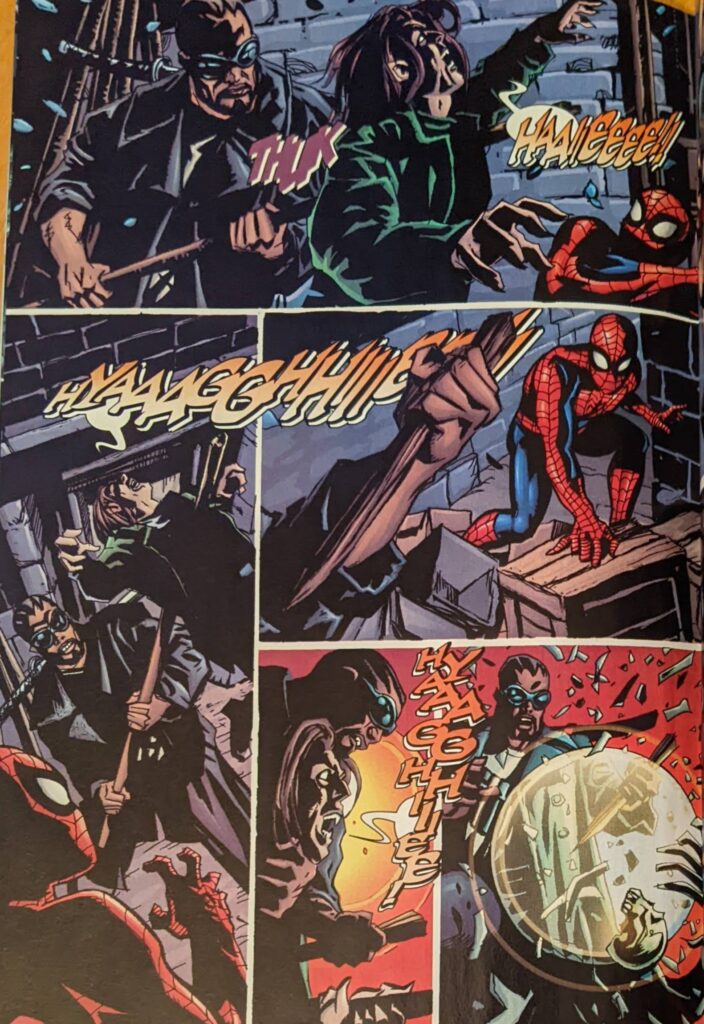
Didn’t we see this movie already? I feel like a previous encounter with Blade went very similarly. But you get a sense pretty quickly for why Brerton’s your guy for spookier stuff.
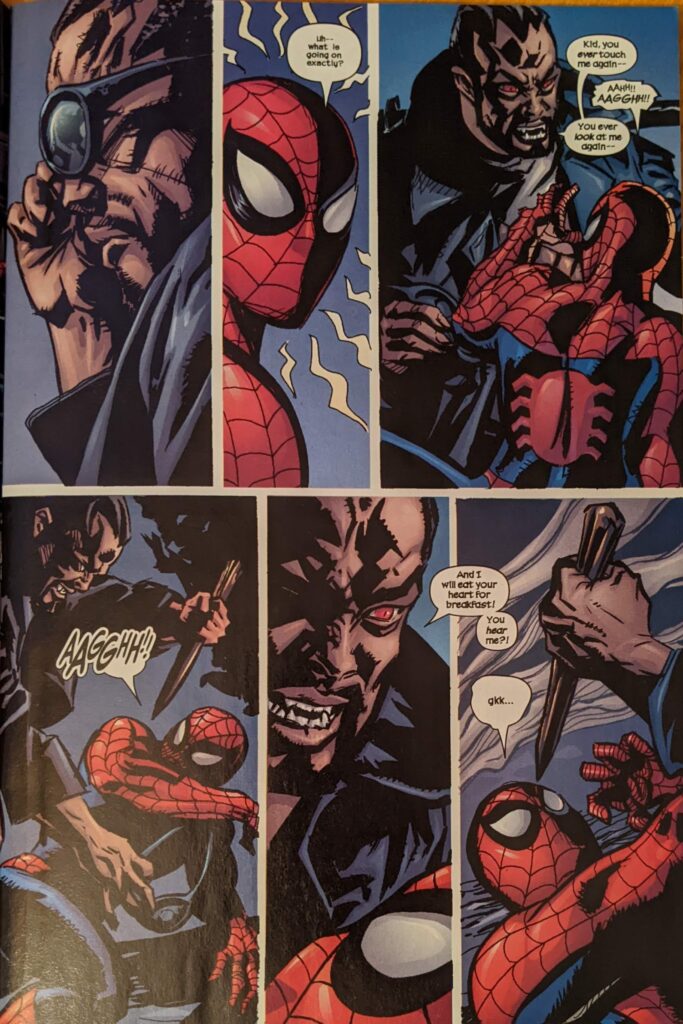
Blade ran off, Spider-Man ran home, and now Peter is telling MJ about how terrifying it was. And they’re drawn by John Romita, Sr. and inked by Al Milgrom. And I don’t know whose fault it is, but the first of their 2 pages is maybe the single worst piece of Romita, Sr. art I’ve ever seen as MJ says she wishes Peter hadn’t told her vampires are real. Luckily, the 2nd page is much better:

Downright surreal to see the Ultimate kids in the unmistakable Romita style. We cut to Frank Cho drawing Elektra running around doing Elektra things. Frank Cho is a talented draftsman really made his career doing stupid cheesecake stuff, and when the industry fffffffinally started to realize maybe that sort of thing isn’t always (or even often!) appropriate, then devoted his life to being a weird creep on the internet. Years from now, his lack of professionalism will make a 6-issue story with Bendis take 10 months to come out, and Bendis will decide never to work with him again. But for now, B is a fan, so Cho is in this, drawing a sexy lady, because obviously. Elektra’s about to assassinate somebody when she is stopped, and you get a real quick idea of the Frank Cho experience:
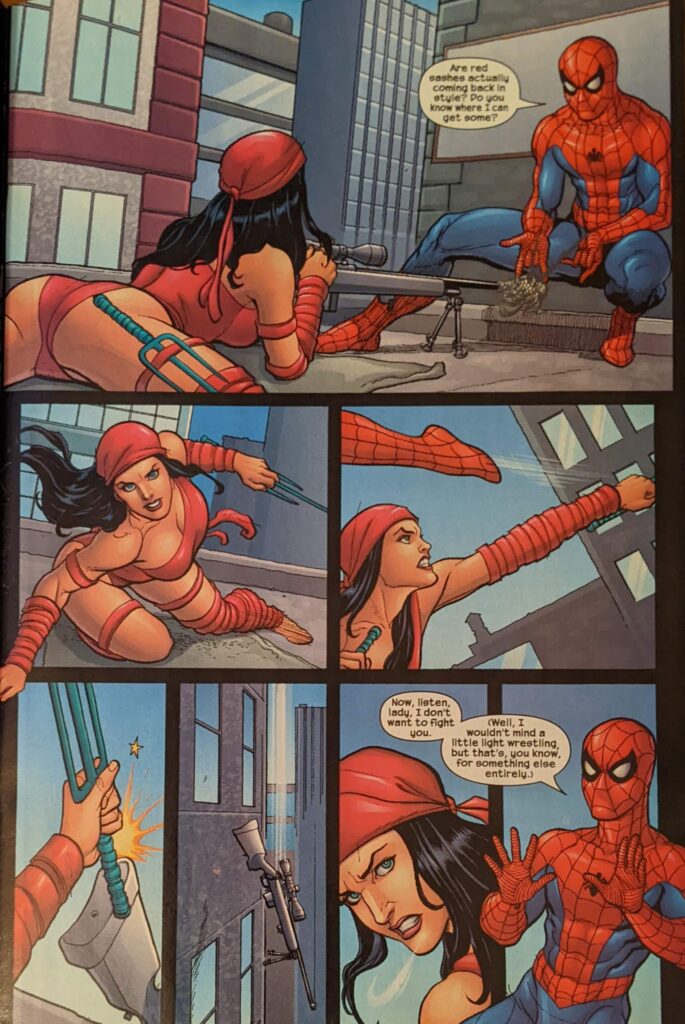
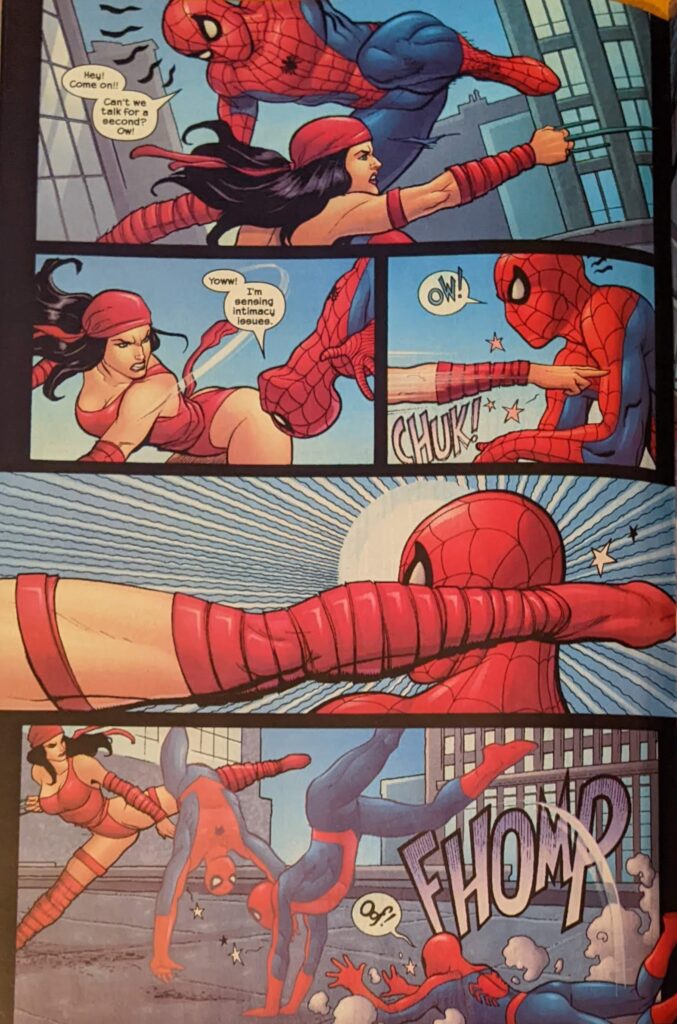
Just goes right for the crotch shot. While he earned his rep for sexualized women and a lot of minute detail, he’s not as good at drawing men, or convincing action, which should be a problem for a comics career, but people are usually too busy drooling over the women to notice, I guess. That is one big, burly 15-year old Spider-Man. He fought Elektra to a shaky stalemate and she just fled. Back in the present, now drawn by a returning Jim Mahfood, Peter shows MJ he found Elektra on a website about serial killers and assassins. And Pete & MJ are dressed completely differently, which is standard for these “jam” books. The picture of Elektra is an Ashley Wood painting, pasted into Mahfood’s panels. Peter then reveals he learned who Elektra was trying to kill, a genocidal monster from an unspecified part of Europe.

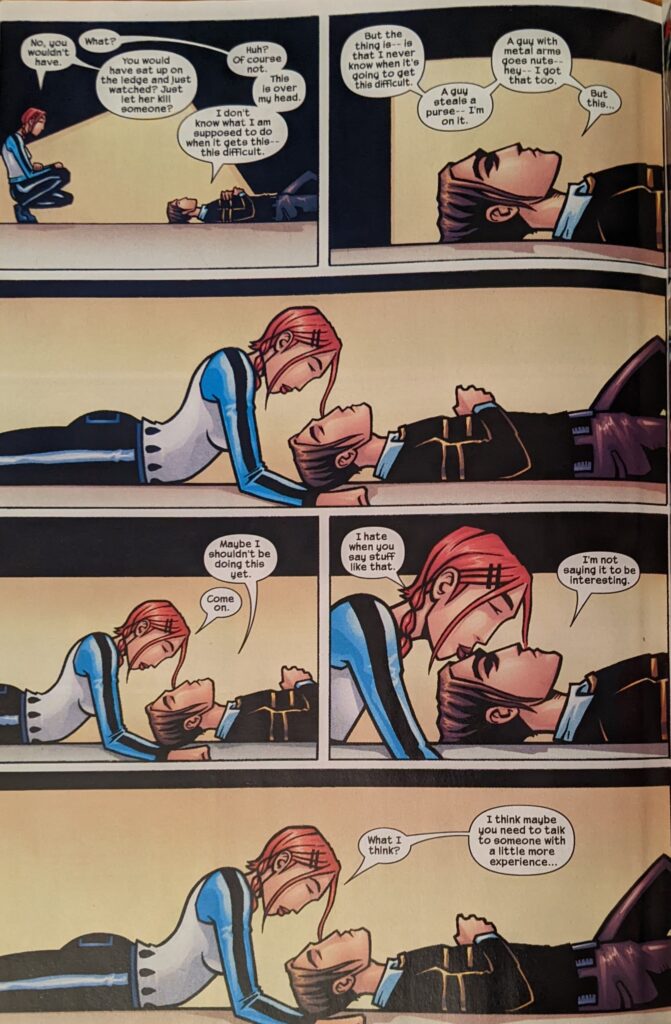
Later, at the offices of Nelson & Murdock, drawn by Scott Morse (One of the names on Quesada’s list in UMTU 9!), Matt’s assistant or something (Karen Page?) tells him that Spider-Man keeps swinging by the window outside. Thus, Daredevil is soon on the roof, being told by Spider-Man that he’s heard DD never leaves Hell’s Kitchen, so he came down trying to get his attention.
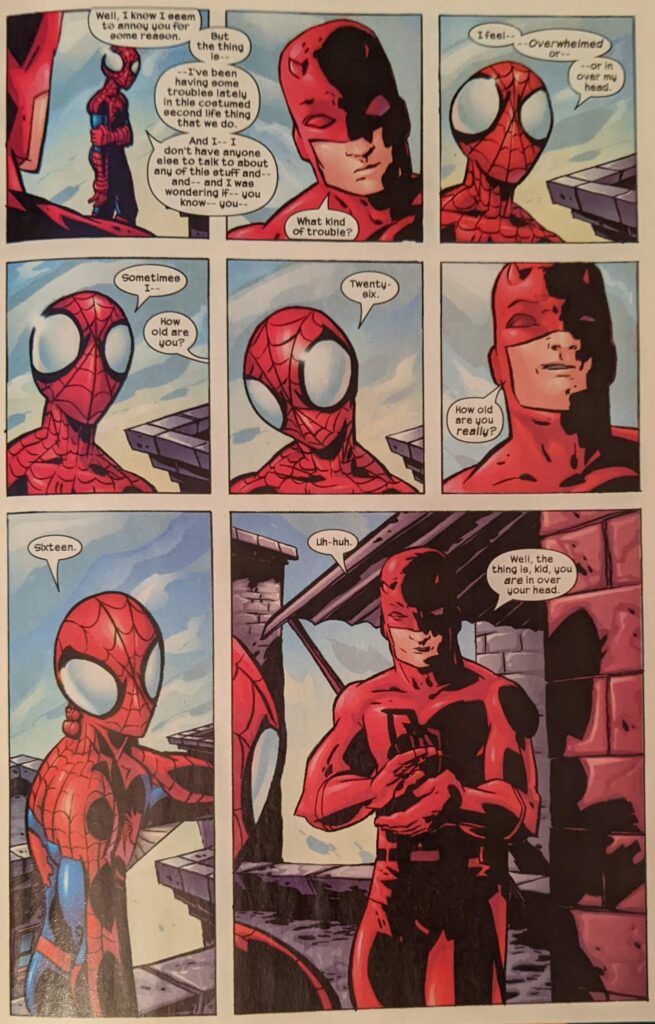
Morse, obviously, is an indie cartoonist, not a mainstream comic book artist, but he winds up getting some mainstream exposure, and even does an Elektra miniseries in a period where letting someone who draws like this handle a book about a sexy lady was unthinkable. It’s quite the finesse for him. I always liked his stuff.

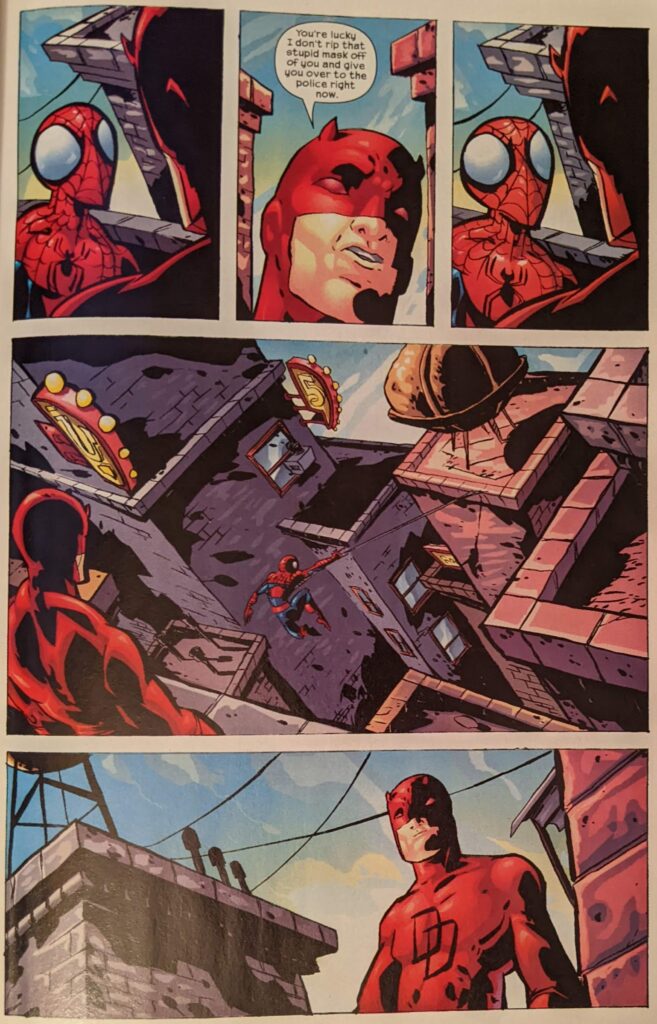
Ultimate DD sure doesn’t like Spider-Man. Hard to find much fault in what he says, tho. Next up is Craig Thompson, who at this point was just the guy who made the modest success Good-Bye Chunky Rice, still a year away from the release of Blankets, his runaway success autobio comic about messy teen romance. And many more years away from Habibi, his completely insane, self-professed “Orientalist” story full of brutal stereotypes set in a Middle East he knew nothing about, commenting on a Quran he didn’t read, using Arabic he didn’t speak. Woof, that book was offputting. Another success, of course. I mean, his cartooning is appealing enough…

…but he really burned all bridges with me with that book. Also Bendis just has him redrawing the superhero assignment sequence from USM, word for word. Why? Only now that scene ends with Peter walking off into a stairwell, overwhelmed. Weird, weird choice. Next comes longtime Bendis collaborator Michael Avon Oeming, whose work I’ve always enjoyed:
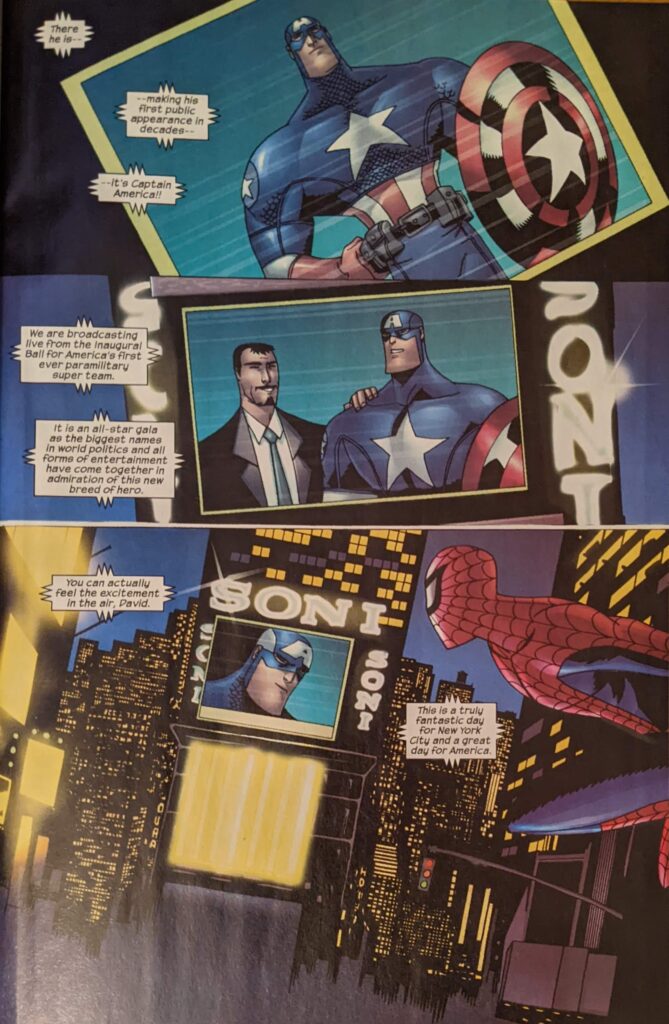
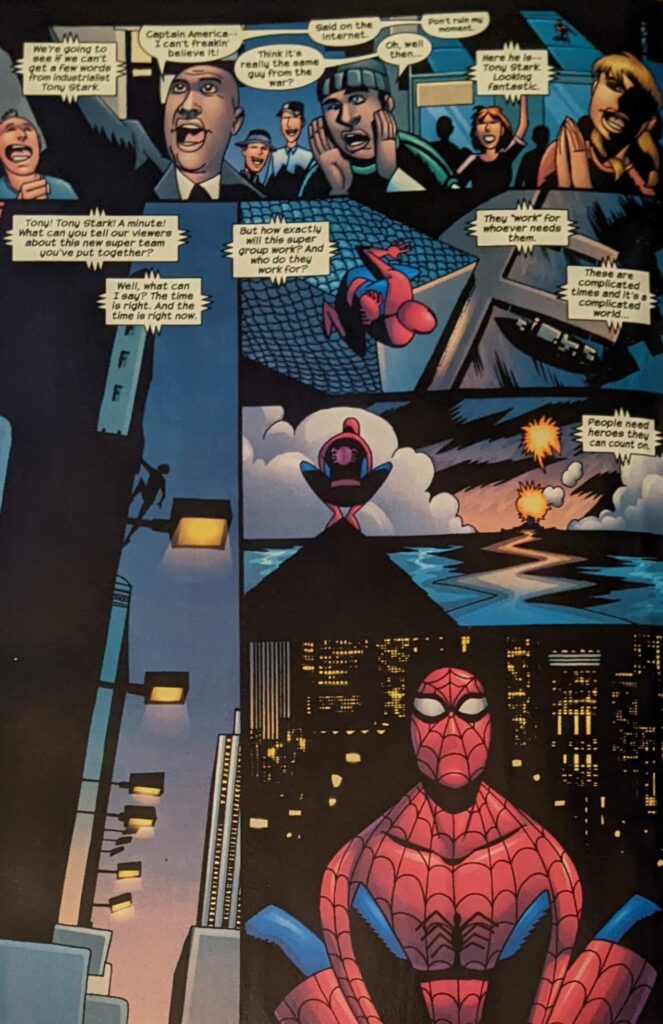
Then the late, great Jason Pearson takes over for a sequence with the FF that can’t have really happened. We saw Pearson’s covers on some ASMs, but as Johnny and the Thing are about to have a classic brawl over a video game, the building’s security system goes off, and we get to see more of Pearson’s truly amazing Spider-Man.
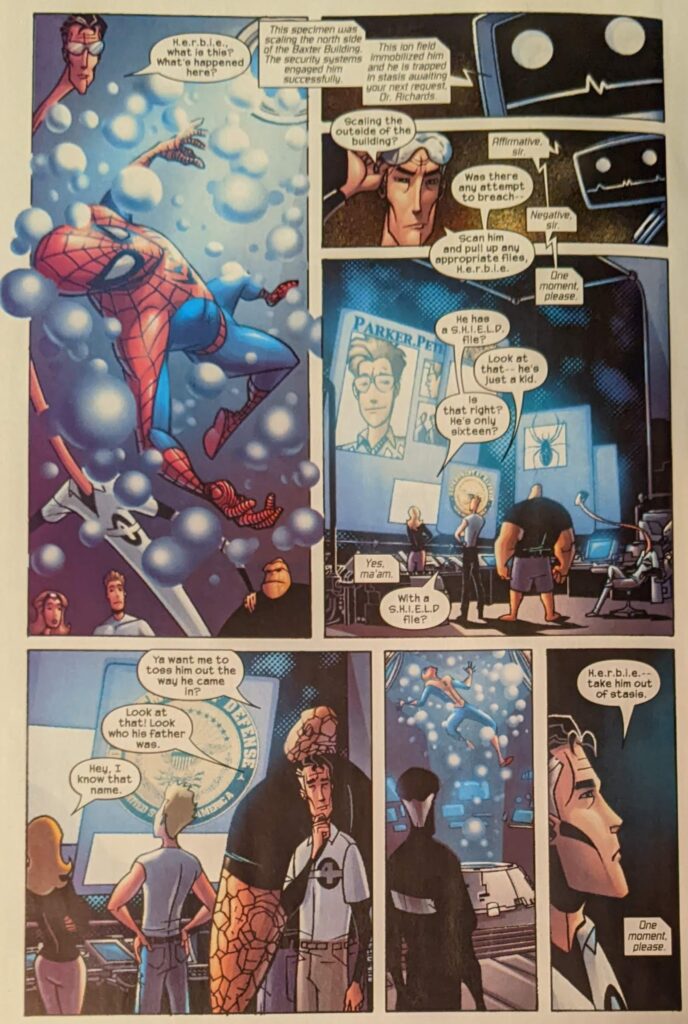


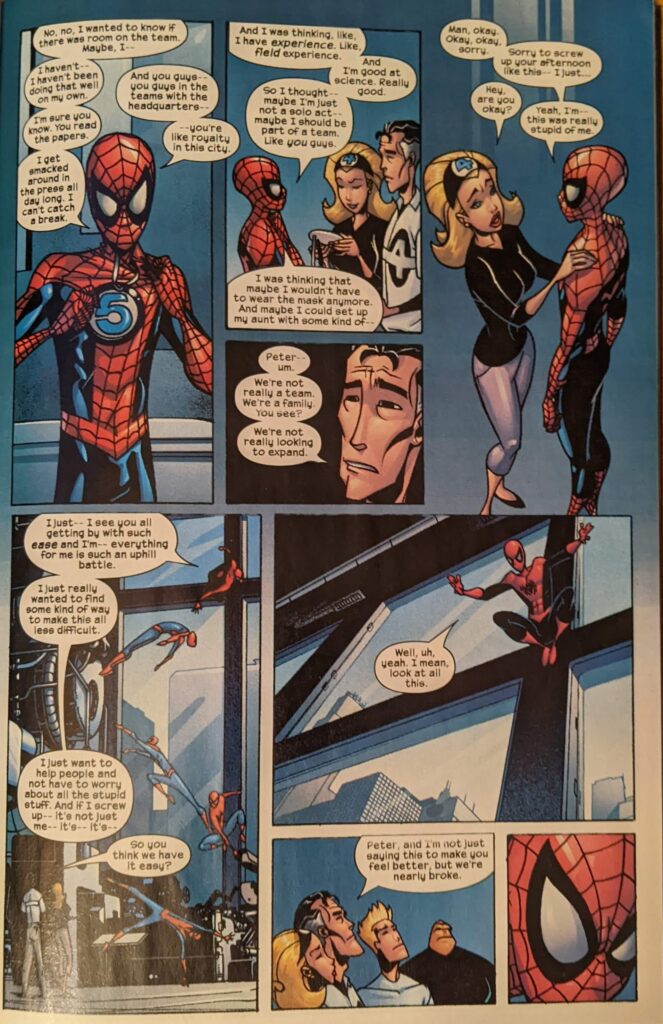
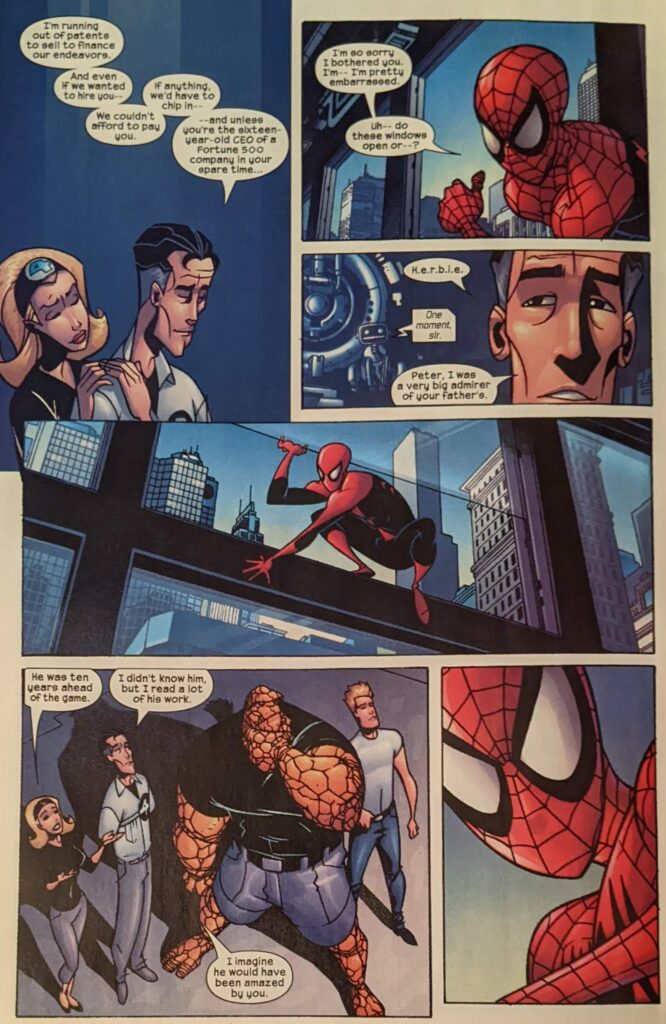
This bit already sort of seems to be disavowing UMTU 9, but even this will eventually be impossible. Look how immaculate that line art is, tho! Man oh man. How Pearson wasn’t one of the biggest guys of his era is baffling to me. So we sort of did the FF part of ASM #1 there, and it was nice, tho it will be rendered moot in a few years. Next, Sean Phillips takes up the baton for 3 pages. Phillips was always a bit of an odd fit in mainstream comics, and once he hooked up with Ed Brubaker, the 2 started a very long and successful partnership doing crime noir stuff. Johnny chases Spider-Man down, tells him what he’s feeling is normal, and reveals the FF are all in therapy (Or were, when they existed in this universe).
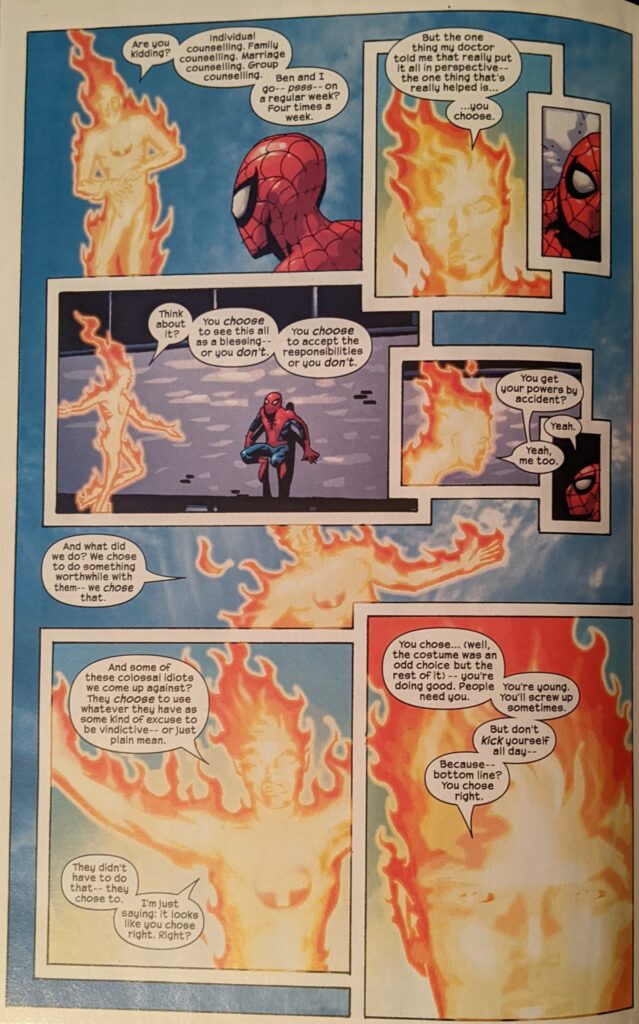
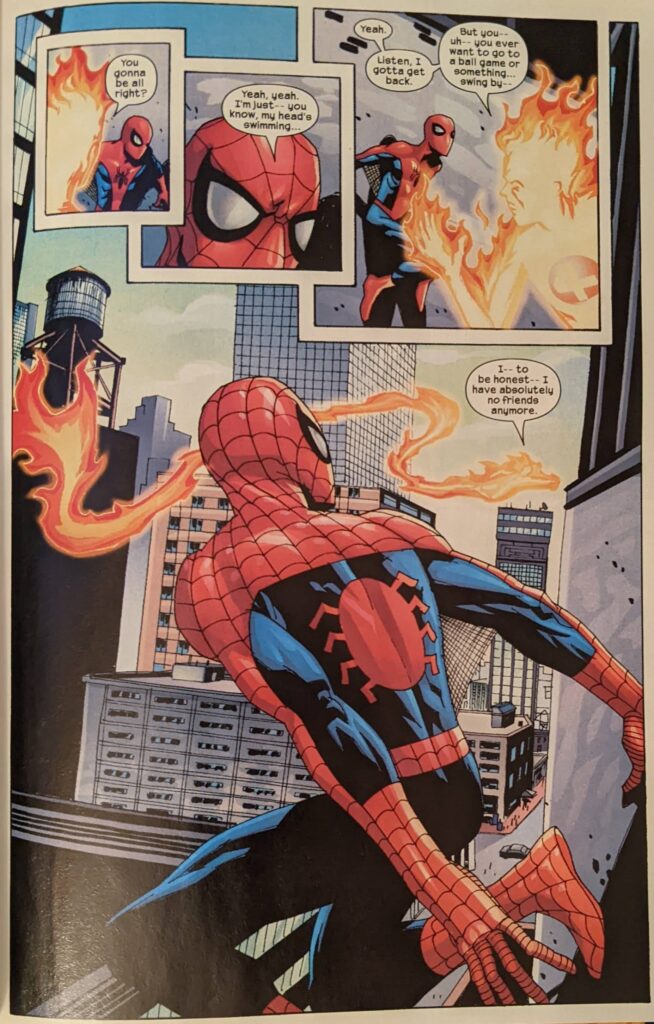
Very classical-looking stuff from Phillips. Next up, Mark Bagley and Rodney Ramos. Couldn’t do this without Bags! His section begins with Kong doing his superhero presentation. He’s come as the Punisher, and is told he got the assignment completely wrong and has a little fight with Gwen that Bendis would never have written now. Weirdly, now that Bags is here, the teacher is a totally different woman from the one in USM who gave them this assignment. Maybe he forgot.
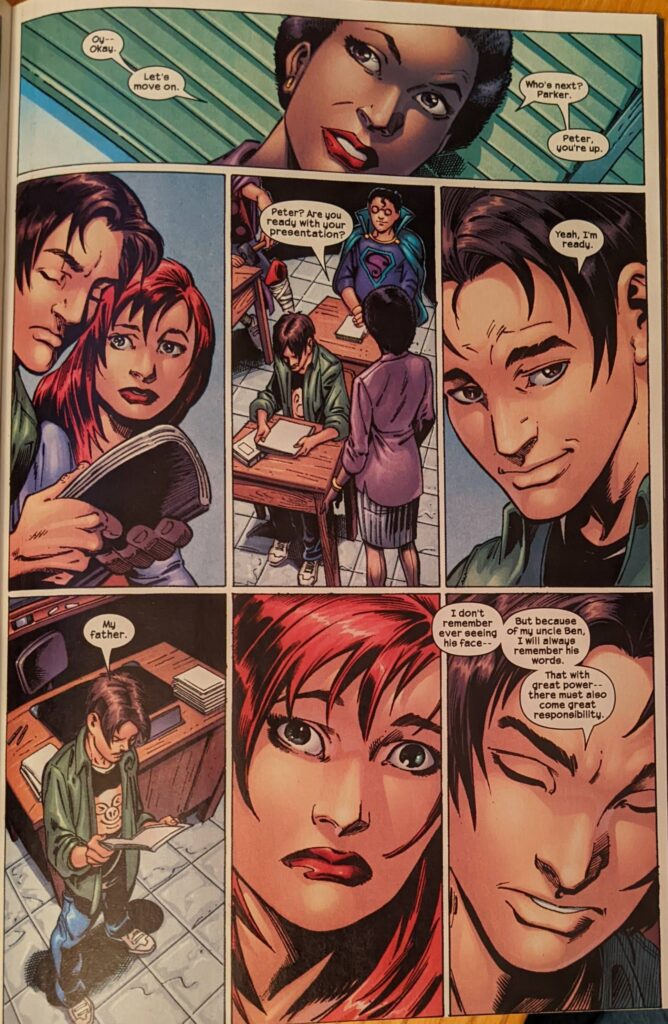
From there, this book becomes what most of Bendis’ jam books are. Peter gives his presentation over 2-page pin-ups of Spider-Man and various other properties by such names as Bill Sienkiewcz, P. Craig Russell, Jason Burrows and Walden Wong, Leonard Kirk and Terry Pallot, Dave Gibbons, Michael Gaydos, James Kochalka, David Mack, Bret Weldele, and Ashely Wood painting Elektra, which is where the picture of her from earlier came from. It’s all nice art, but half this book is superfluous because the art isn’t telling the story. Some of the 2-page spreads don’t even have a complete sentence on them. This becomes a poster book instead of a comic book. Bret Weldele is an interesting name because I don’t know it. This book is full of revered comics legends, then-current mainstream stars and then-current indie cartoonists, and this is the only name I don’t know. Curious. Well, Bags returns to close out the book, now inked by main series inker Art Thibert. And you can tell from the captions that you really didn’t even miss anything of substance from Peter’s presentation by not seeing pages 42-61 of this 64 page comic. I mean, that’s nuts.
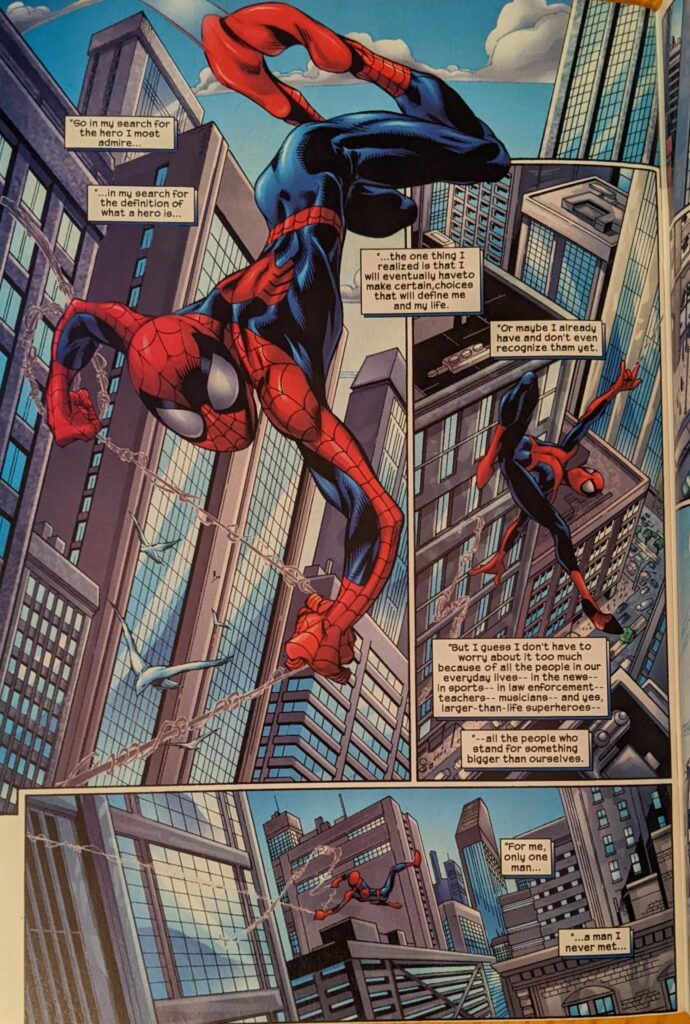

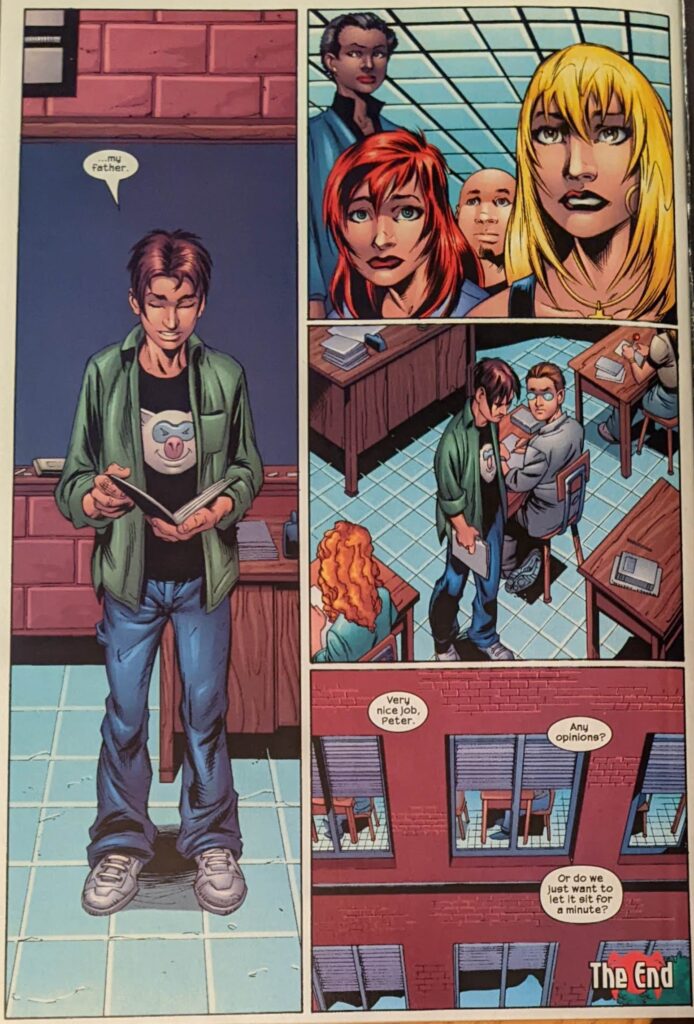
For all my complaining, it’s a nice ending. And a nice place to end this block. Ultimate Spider-Man was hard to beat, by any comic, in this era, but it’s time to get back to the main books’ not-too-shabby attempts to do so.

